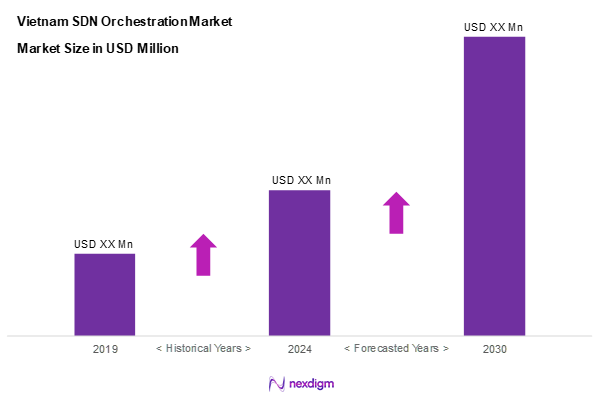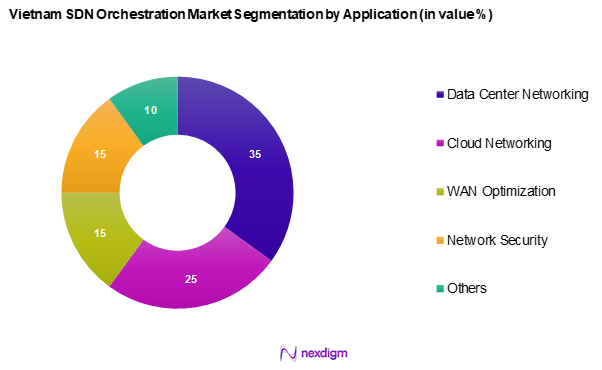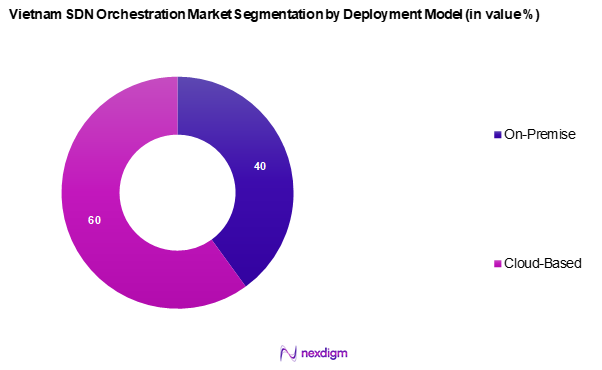Market Overview
As of 2024, the Vietnam SDN orchestration market is valued at USD 55.9 million, with a growing CAGR of 48.7% from 2024 to 2030, this is reflecting a substantial increase in demand driven by the rapid adoption of cloud technologies and the need for efficient network management solutions. The enhancement of telecommunications infrastructure and an increasing number of data centres in the region contribute significantly to this growth, supported by substantial investment from both private and public sectors. Increased organizational focus on digital transformation underlines the growing relevance of SDN technologies.
Dominant cities in the Vietnam SDN orchestration market include Ho Chi Minh City and Hanoi, owing to their status as key economic hubs. These cities host a concentration of telecommunications companies and tech start-ups, fostering a robust ecosystem for SDN implementation. The government’s push for smart city initiatives and modernization of telecommunications infrastructure further solidifies the position of these urban areas as leaders in the market, driving innovation and demand for advanced networking solutions.

Market Segmentation
By Application
The Vietnam SDN orchestration market is segmented into data centre networking, cloud networking, wan optimization, network security, and others. Data centre networking maintains a dominant market position owing to the increasing reliance on data centres for managing vast volumes of data and applications. With the rapid expansion of enterprises utilizing cloud services, efficient data centre operations have become critical. Companies are recognizing the need for agility and flexibility in managing their networking resources, resulting in widespread adoption of SDN solutions in data centre environments.

By Deployment Model
The Vietnam SDN orchestration market is segmented into on-premise and cloud-based. The cloud-based segment dominate the market due to its scalability and cost-effectiveness, which are highly attractive to businesses. As organizations seek to reduce capital expenditures while increasing operational efficiency, the shift towards cloud-based solutions becomes evident. The flexibility and reduced maintenance burdens associated with cloud deployments also contribute to its growing dominance in the SDN landscape in Vietnam.

Competitive Landscape
The Vietnam SDN orchestration market is dominated by a few major players, including local firms and international giants that significantly shape the industry’s landscape. These companies leverage technological expertise and established networks to maintain a competitive edge in the rapidly evolving SDN environment.
| Company | Establishment Year | Headquarters | Company Revenue | Business Strategies | Global Presence | Business Segment Revenue | Weakness |
| Cisco Systems | 1984 | San Jose, USA | – | – | – | – | – |
| VMware | 1998 | Palo Alto, USA | – | – | – | – | – |
| Huawei Technologies | 1987 | Shenzhen, China | – | – | – | – | – |
| Juniper Networks | 1996 | Sunnyvale, USA | – | – | – | – | – |
| Arista Networks | 2004 | Santa Clara, USA | – | – | – | – | – |

Vietnam SDN Orchestration Market Analysis
Growth Drivers
Increased Bandwidth Demand
The rapid growth in digital content consumption is fuelling an unprecedented demand for bandwidth in Vietnam. With internet penetration rates projected to reach 71% by the end of 2025, higher than the global average of 64%, the nation is investing heavily in its telecommunications infrastructure. As of 2023, Vietnam ranked 12th globally in online activity, indicating a substantial rise in data consumption, which is expected to continue. This surge necessitates more effective network management solutions, particularly SDN orchestrations, to handle increased data loads efficiently. Increasing mobile data usage, which exceeded 12.3 GB per subscriber in 2022, further accentuates the need for responsive network architectures.
Efficiency in Network Management
Organizations are increasingly prioritizing operational efficiency, driving the adoption of SDN technologies. As the volume of network traffic rises, efficient network management has become critical. According to the Ministry of Information and Communications of Vietnam, the country’s overall internet traffic increased by 48% in 2023 compared to 2022. Additionally, global IT spending on digital transformation is expected to surpass USD 2.8 trillion by 2025, of which network management efficiency is a vital component. This need for streamlining operations effectively positions SDN orchestration as a favoured solution among enterprises seeking to reduce operational complexity while improving service delivery.
Market Challenges
High Implementation Costs
Despite the benefits of SDN orchestration, the high initial investment can deter organizations from adopting these solutions. As per the Vietnamese Ministry of Information and Communications, the cost of replacing legacy systems with advanced SDN technology often reaches roughly USD 3 million for mid-sized enterprises. This upfront capital requirement poses a significant barrier, especially for smaller organizations that may struggle to allocate a sufficient budget towards technological upgrades. The benefits of SDN must be constantly communicated to highlight the long-term cost savings versus the initial expenditure to justify these investments.
Complexity in Integration
Integrating SDN orchestration within the existing IT framework presents a challenge for many organizations. According to the IT Infrastructure Library (ITIL) guidelines used by Vietnamese enterprises, around 60% of organizations report integration complexities as a substantial hurdle in SDN implementation. Enterprises face disruptions during transitions, which can lead to temporary service outages and potential loss of business continuity. Moreover, a lack of skilled personnel who are adept at managing these new technologies exacerbates the integration challenges faced by companies, delaying their transition to SDN-based infrastructures.
Opportunities
Deployment in Smart Cities
Vietnam is on a rapid path to urbanization, with major cities embarking on smart city initiatives. For instance, Ho Chi Minh City has projected investments of approximately USD 1.5 billion towards enhancing digital infrastructure by 2025. The government aims for 10% of its urban area designated as smart zones with integrated SDN networks, significantly promoting SDN deployment. This push is indicative of a broader strategy to leverage innovation and technology to improve infrastructure efficiency, making smart city deployments ripe with opportunities for SDN implementation.
Advancements in Technology
The rapid pace of technological advancements provides substantial opportunities for the growth of the SDN orchestration market in Vietnam. The government has established a policy framework to support the integration of emerging technologies in sectors like telecommunications and IT. Significant funding, estimated at USD 3 billion over several years, is being directed towards research and development in automation and artificial intelligence, key drivers that are integral to advancing SDN technologies. As companies are encouraged to embrace next-generation infrastructure, the rapidly evolving tech landscape in Vietnam fosters an environment conducive to the expansion and deployment of innovative SDN solutions. This combination of government support and technological evolution positions the SDN orchestration market for significant opportunities in addressing the complex needs of modern networking environments.
Future Outlook
Over the next five years, the Vietnam SDN orchestration market is poised for significant growth, driven by continuous government support, advancements in network technology, and surging demand from enterprises seeking more efficient and reliable network solutions. The shift towards digital transformation across various industries will further necessitate the implementation of SDN technologies, allowing for enhanced operational efficiency and reduced costs. As businesses increasingly prioritize agility and scalability, the market is expected to witness robust expansion and innovation.
Major Players
- Cisco Systems
- VMware
- Huawei Technologies
- Juniper Networks
- Arista Networks
- Nokia
- Ciena Corporation
- Extreme Networks
- NETCONF Group
- Pluribus Networks
- Intel Corporation
- Mellanox Technologies
- Spirent Communications
- Ixia (Keysight Technologies)
- Trend Micro
Key Target Audience
- Telecommunications Operators
- Data Center Providers
- Cloud Service Providers
- Large Enterprises (IT Departments)
- Investments and Venture Capitalist Firms
- Government and Regulatory Bodies (Vietnam Ministry of Information and Communications)
- Network Security Firms
- System Integrators
Research Methodology
Step 1: Identification of Key Variables
The initial phase involves constructing an ecosystem map encompassing all major stakeholders within the Vietnam SDN orchestration Market. This step is underpinned by extensive desk research, utilizing a combination of secondary and proprietary databases to gather comprehensive industry-level information. The primary objective is to identify and define the critical variables that influence market dynamics.
Step 2: Market Analysis and Construction
In this phase, we compile and analyse historical data pertaining to the Vietnam SDN Orchestration Market. This includes assessing market penetration, the ratio of marketplaces to service providers, and the resultant revenue generation. Furthermore, an evaluation of service quality statistics will be conducted to ensure the reliability and accuracy of the revenue estimates.
Step 3: Hypothesis Validation and Expert Consultation
Market hypotheses will be developed and subsequently validated through Computer-Assisted Telephone Interviews (CATIs) with industry experts representing a diverse array of companies. These consultations will provide valuable operational and financial insights directly from industry practitioners, which will be instrumental in refining and corroborating the market data.
Step 4: Research Synthesis and Final Output
The final phase involves direct engagement with multiple SDN orchestration manufacturers to acquire detailed insights into product segments, sales performance, consumer preferences, and other pertinent factors. This interaction will serve to verify and complement the statistics derived from the bottom-up approach, thereby ensuring a comprehensive, accurate, and validated analysis of the Vietnam SDN Orchestration market.
- Executive Summary
- Research Methodology
(Market Definitions and Assumptions, Abbreviations, Market Sizing Approach, Consolidated Research Approach, Understanding Market Potential Through In-Depth Industry Interviews, Primary Research Approach, Limitations and Future Conclusions)
- Definition and Scope
- Overview Genesis
- Timeline of Major Players
- Business Cycle
- Supply Chain and Value Chain Analysis
- Growth Drivers
Increased Bandwidth Demand
Efficiency in Network Management - Market Challenges
High Implementation Costs
Complexity in Integration - Opportunities
Deployment in Smart Cities
Advancements in Technology - Trends
Shift Towards AI-integrated SDN Solutions
Growing Focus on Network Security - Government Regulation
IT Infrastructure Policies
Data Privacy Regulations - SWOT Analysis
- Stakeholder Ecosystem
- Porter’s Five Forces Analysis
- By Value, 2019-2024
- By Volume, 2019-2024
- By Average Revenue per User (ARPU), 2019-2024
- By Adoption Rate, 2019-2024
- By Application (In Value)
Data Center Networking
– Virtual Network Provisioning
– Traffic Management & Load Balancing
– Storage Network Orchestration
Cloud Networking
– Multi-Cloud Connectivity
– Cloud WAN Orchestration
– Cloud-Based Virtual Routing
WAN Optimization
– SD-WAN Integration
-Bandwidth Allocation
– Latency Reduction Tools
Network Security
– Policy-Based Routing
– Dynamic Threat Response
– Firewall & Intrusion Detection Orchestration
Others
– IoT Network Management
– Edge Computing Connectivity
– Network Slicing - By Deployment Model (In Value)
On-premise
– Privately Managed Controllers
– Customizable Infrastructure
– Localized Data Control
Cloud-based
– Centralized Orchestration Platforms
– Subscription-Based Models
– Remote Accessibility & Scalability - By End-User Industry (In Value)
Cloud Services Providers
– Data Sovereignty & Compliance Tools
– High Availability Orchestration
Telecommunications
– 5G Network Orchestration
– Virtualized Core Network Automation
Banking & Finance
– Secure Network Segmentation
– Regulatory-Compliant Network Architecture
Government
– Defense & Critical Infrastructure Networks
– Inter-departmental Network Management
Healthcare
– HIPAA-Grade Security Layers
– Hospital & Lab Network Routing
Others
– Retail Chains
– Educational Institutions
– Transportation & Logistics - By Region (In Value)
Northern Region
Southern Region
Central Region - By Component (In Value)
Software
– SDN Controllers
– Network Management Tools
– APIs & Integration Frameworks
Services
– Consulting & Planning
– Implementation & Deployment
– Support & Managed Services - By Organization Size (In Value)
Large Enterprises
Medium-Sized Enterprises
Small Sized Enterprises
- Market Share of Major Players on the Basis of Value/Volume, 2024
Market Share of Major Players by Type of Application Segment, 2024 - Cross Comparison Parameters (Company Overview, Business Strategies, Recent Developments, Strengths, Weaknesses, Organizational Structure, Revenues, Business Segment Revenue, Technological Advancements, Customer Satisfaction Scores, Innovation Capacity, Global Presence)
- SWOT Analysis of Key Players
- Pricing Analysis Basis SKUs for Major Players
- Profiles of Major Companies
Cisco Systems
VMware
Nokia
Huawei Technologies
Juniper Networks
Arista Networks
Ericsson
Mellanox Technologies
Ciena Corporation
Extreme Networks
Brocade Communications Systems
Pluribus Networks
Metaswitch Networks
Intel Corporation
Spirent Communications
- Demand and Utilization Patterns
- Budget Allocation Strategies
- Compliance and Regulatory Requirements
- Needs and Pain Point Analysis
- Decision-Making Processes
- By Value Forecast, 2025-2030
- By Volume Forecast, 2025-2030
- By ARPU Forecast, 2025-2030
- By Adoption Rate Forecast, 2025-2030


